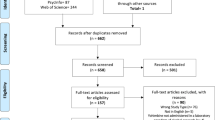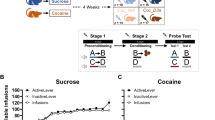Abstract
Converging evidence suggests a role for noradrenergic mechanisms in stress-induced reinstatement of cocaine seeking in animals. Yohimbine, an α2-adrenoceptor antagonist, is known to be anxiogenic and induce stress-related responses in humans and animals. Here, we tested the ability of yohimbine to reinstate cocaine-seeking behavior and induce behavioral and physiological signs characteristic of stress in squirrel monkeys. Monkeys were trained to self-administer cocaine under a second-order schedule of i.v. drug injection. Drug seeking subsequently was extinguished by substituting saline for cocaine injections and omitting the cocaine-paired stimulus. The ability of yohimbine and the structurally distinct α2-adrenoceptor antagonist RS-79948 to reinstate cocaine-seeking behavior was assessed by administering priming injections immediately before test sessions in which the cocaine-paired stimulus was either present or absent. Priming injections of yohimbine (0.1–0.56 mg/kg, i.m.) or RS-79948 (0.01–0.1 mg/kg, i.m.) induced dose-related reinstatement of cocaine-seeking behavior. The magnitude of yohimbine-induced reinstatement was similar regardless of the presence or absence of the cocaine-paired stimulus. Yohimbine also significantly increased salivary cortisol levels, a physiological marker of stress, as well as scratching and self-grooming, behavioral markers of stress in nonhuman primates. In drug interaction experiments, pretreatment with the α2-adrenoceptor agonist clonidine (0.1–0.3 mg/kg, i.m.) dose-dependently inhibited yohimbine-induced reinstatement of cocaine seeking. In contrast, pretreatment with the dopamine receptor antagonist flupenthixol failed to inhibit yohimbine-induced reinstatement of cocaine seeking. The results show that pharmacological blockade of α2-adrenoceptors can induce reinstatement of cocaine-seeking behavior and characteristic stress responses in squirrel monkeys, providing a potentially useful model of stress-induced relapse to drug seeking.
Similar content being viewed by others
Log in or create a free account to read this content
Gain free access to this article, as well as selected content from this journal and more on nature.com
or
References
Albus M, Zahn TP, Breier A (1992). Anxiogenic properties of yohimbine. I. Behavioral, physiological and biochemical measures. Eur Arch Psychiatry Clin Neurosci 241: 337–344.
Boyajian CL, Leslie FM (1987). Pharmacological evidence for alpha-2 adrenoceptor heterogeneity: differential binding properties of [3H]rauwolscine and [3H]idazoxan in rat brain. J Pharmacol Exp Ther 241: 1092–1098.
Bremner JD, Krystal JH, Southwick SM, Charney DS (1996). Noradrenergic mechanisms in stress and anxiety: II. Clinical studies. Synapse 23: 39–51.
Carey G, Spealman RD (1998). Models of neurological disease (substance abuse): self-administration in monkeys. In: Enna SJ, Williams M, Ferkany JW, Kenakin T, Porsolt RD, Sullivan JP (eds). Current Protocols in Pharmacology. John Wiley and Sons: New York, 10.15.11–10.15.15.
Carey GJ, Costall B, Domeney AM, Jones DN, Naylor RJ (1992). Behavioural effects of anxiogenic agents in the common marmoset. Pharmacol Biochem Behav 42: 143–153.
Carroll ME (1985). The role of food deprivation in the maintenance and reinstatement of cocaine-seeking behavior in rats. Drug Alcohol Depend 16: 95–109.
Castles DL, Whiten A, Aureli F (1999). Social anxiety, relationships and self-directed behaviour among wild female olive baboons. Anim Behav 58: 1207–1215.
Charney DS, Heninger GR, Redmond Jr DE (1983). Yohimbine induced anxiety and increased noradrenergic function in humans: effects of diazepam and clonidine. Life Sci 33: 19–29.
Charney DS, Woods SW, Heninger GR (1989). Noradrenergic function in generalized anxiety disorder: effects of yohimbine in healthy subjects and patients with generalized anxiety disorder. Psychiatry Res 27: 173–182.
Clark RD, Repke DB, Kilpatrick AT, Brown CM, MacKinnon AC, Clague RU et al (1989). (8a alpha,12a alpha,13a alpha)-5,8,8a,9,10,11,12,12a,13,13a-decahydro-3-methoxy-12-(methylsulfonyl)-6H-isoquino[2,1-g][1,6]naphthyridi ne, a potent and highly selective alpha 2-adrenoceptor antagonist. J Med Chem 32: 2034–2036.
Cooper JR, Bloom FE, Roth RH (1991). The Biochemical Basis of Neuropharmacology. Oxford: New York. 181pp.
Coplan JD, Rosenblum LA, Friedman S, Bassoff TB, Gorman JM (1992). Behavioral effects of oral yohimbine in differentially reared nonhuman primates. Neuropsychopharmacology 6: 31–37.
Doxey JC, Lane AC, Roach AG, Virdee NK (1984). Comparison of the alpha-adrenoceptor antagonist profiles of idazoxan (RX 781094), yohimbine, rauwolscine and corynanthine. Naunyn Schmiedebergs Arch Pharmacol 325: 136–144.
Erb S, Hitchcott PK, Rajabi H, Mueller D, Shaham Y, Stewart J (2000). Alpha-2 adrenergic receptor agonists block stress-induced reinstatement of cocaine seeking. Neuropsychopharmacology 23: 138–150.
File SE (1986). Aversive and appetitive properties of anxiogenic and anxiolytic agents. Behav Brain Res 21: 189–194.
Grunhaus L, Tiongco D, Zelnik T, Flegel P, Hollingsworth PJ, Smith CB (1989). Intravenous yohimbine. Selective enhancer of norepinephrine and cortisol secretion and systolic blood pressure in humans. Clin Neuropharmacol 12: 106–114.
Hall SM, Havassy BE, Wasserman DA (1991). Effects of commitment to abstinence, positive moods, stress, and coping on relapse to cocaine use. J Consult Clin Psychol 59: 526–532.
Harris JC, Newman JD (1987). Mediation of separation distress by alpha 2-adrenergic mechanisms in a non-human primate. Brain Res 410: 353–356.
Hume SP, Ashworth S, Lammertsma AA, Opacka-Juffry J, Law MP, McCarron JA et al (1996). Evaluation in rat of RS-79948-197 as a potential PET ligand for central alpha 2-adrenoceptors. Eur J Pharmacol 317: 67–73.
Johanson CE, Barrett JE (1993). The discriminative stimulus effects of cocaine in pigeons. J Pharmacol Exp Ther 267: 1–8.
Khroyan TV, Barrett-Larimore RL, Rowlett JK, Spealman RD (2000). Dopamine D1- and D2-like receptor mechanisms in relapse to cocaine-seeking behavior: effects of selective antagonists and agonists. J Pharmacol Exp Ther 294: 680–687.
Kreek MJ, Koob GF (1998). Drug dependence: stress and dysregulation of brain reward pathways. Drug Alcohol Depend 51: 23–47.
Leri F, Flores J, Rodaros D, Stewart J (2002). Blockade of stress-induced but not cocaine-induced reinstatement by infusion of noradrenergic antagonists into the bed nucleus of the stria terminalis or the central nucleus of the amygdala. J Neurosci 22: 5713–5718.
Liu X, Weiss F (2002). Additive effect of stress and drug cues on reinstatement of ethanol seeking: exacerbation by history of dependence and role of concurrent activation of corticotropin-releasing factor and opioid mechanisms. J Neurosci 22: 7856–7861.
McDougle CJ, Black JE, Malison RT, Zimmermann RC, Kosten TR, Heninger GR et al (1994). Noradrenergic dysregulation during discontinuation of cocaine use in addicts. Arch Gen Psychiatry 51: 713–719.
McKay JR, Rutherford MJ, Alterman AI, Cacciola JS, Kaplan MR (1995). An examination of the cocaine relapse process. Drug Alcohol Depend 38: 35–43.
McKearney JW (1983). Effects of clonidine on operant behavior and electric shock titration in the squirrel monkey: effects of alpha 2-adrenoreceptor antagonism. Neuropharmacology 22: 775–779.
Milligan CM, Linton CJ, Patmore L, Gillard N, Ellis GJ, Towers P (1997). [3H]-RS-79948-197, a high affinity radioligand selective for alpha 2-adrenoceptor subtypes. Ann NY Acad Sci 812: 176–177.
Platt DM, Rowlett JK, Spealman RD (2000). Dissociation of cocaine-antagonist properties and motoric effects of the D1 receptor partial agonists SKF 83959 and SKF 77434. J Pharmacol Exp Ther 293: 1017–1026.
Platt DM, Rowlett JK, Spealman RD (2001). Monoaminergic transport mechanisms in relapse to cocaine-seeking behavior. Society for Neuroscience Abstract Viewer/Itinerary Planner: Program No.788.782.
Scatton B, Zivkovic B, Dedek J (1980). Antidopaminergic properties of yohimbine. J Pharmacol Exp Ther 215: 494–499.
Schino G, Perretta G, Taglioni AM, Monaco V, Troisi A (1996). Primate displacement activities as an ethopharmacological model of anxiety. Anxiety 2: 186–191.
Self DW, Nestler EJ (1998). Relapse to drug-seeking: neural and molecular mechanisms. Drug Alcohol Depend 51: 49–60.
Shaham Y, Erb S, Stewart J (2000). Stress-induced relapse to heroin and cocaine seeking in rats: a review. Brain Res—Brain Res Rev 33: 13–33.
Shaham Y, Shalev U, Lu L, De Wit H, Stewart J (2003). The reinstatement model of drug relapse: history, methodology and major findings. Psychopharmacology 168: 3–20.
Shaham Y, Stewart J (1996). Effects of opioid and dopamine receptor antagonists on relapse induced by stress and re-exposure to heroin in rats. Psychopharmacology 125: 385–391.
Shalev U, Grimm JW, Shaham Y (2002). Neurobiology of relapse to heroin and cocaine seeking: a review. Pharmacol Rev 54: 1–42.
Shalev U, Highfield D, Yap J, Shaham Y (2000). Stress and relapse to drug seeking in rats: studies on the generality of the effect. Psychopharmacology 150: 337–346.
Shalev U, Yap J, Shaham Y (2001). Leptin attenuates acute food deprivation-induced relapse to heroin seeking. J Neurosci 21: RC129 (121–125).
Sinha R (2001). How does stress increase risk of drug abuse and relapse? Psychopharmacology 158: 343–359.
Southwick SM, Krystal JH, Morgan CA, Johnson D, Nagy LM, Nicolaou A et al (1993). Abnormal noradrenergic function in posttraumatic stress disorder. Arch Gen Psychiatry 50: 266–274.
Spealman RD (1990). Antagonism of behavioral effects of cocaine by selective dopamine receptor blockers. Psychopharmacology 101: 142–145.
Spealman RD, Barrett-Larimore RL, Rowlett JK, Platt DM, Khroyan TV (1999). Pharmacological and environmental determinants of relapse to cocaine-seeking behavior. Pharmacol Biochem Behav 64: 327–336.
Spealman RD, Lee B, Tiefenbacher S, Platt DM, Rowlett JK, Khroyan TV (2004). Triggers of relapse: Nonhuman primate models of reinstated cocaine seeking. In: Bevins R, Bardo MT (eds). Nebraska Symposium on Motivation: Motivational Factors in the Etiology of Drug Abuse. University of Nebraska Press: Lincoln. pp 57–84.
Stanford SC (1995). Central noradrenergic neurones and stress. Pharmacol Ther 68: 297–342.
Stewart J (2000). Pathways to relapse: the neurobiology of drug- and stress-induced relapse to drug-taking. J Psychiatry Neurosci 25: 125–136.
Stine SM, Southwick SM, Petrakis IL, Kosten TR, Charney DS, Krystal JH (2002). Yohimbine-induced withdrawal and anxiety symptoms in opioid-dependent patients. Biol Psychiatry 51: 642–651.
Tiefenbacher S, Lee B, Meyer JS, Spealman RD (2003). Noninvasive technique for the repeated sampling of salivary free cortisol in awake, unrestrained squirrel monkeys. Am J Primatol 60: 69–75.
White DA, Birkle DL (2001). The differential effects of prenatal stress in rats on the acoustic startle reflex under baseline conditions and in response to anxiogenic drugs. Psychopharmacology 154: 169–176.
Winter JC, Rabin RA (1992). Yohimbine as a serotonergic agent: evidence from receptor binding and drug discrimination. J Pharmacol Exp Ther 263: 682–689.
Wood DM, Lal H, Yaden S, Emmett-Oglesby MW (1985). One-way generalization of clonidine to the discriminative stimulus produced by cocaine. Pharmacol Biochem Behav 23: 529–533.
Acknowledgements
We thank Ms Bethann Johnson for technical contributions and Mrs Donna Reed for the preparation of this paper. This work was supported by grants from the National Institute on Drug Abuse (DA00499, DA11054) and the National Center for Research Resources (RR00168).
Author information
Authors and Affiliations
Corresponding author
Rights and permissions
About this article
Cite this article
Lee, B., Tiefenbacher, S., Platt, D. et al. Pharmacological Blockade of α2-Adrenoceptors Induces Reinstatement of Cocaine-Seeking Behavior in Squirrel Monkeys. Neuropsychopharmacol 29, 686–693 (2004). https://doi.org/10.1038/sj.npp.1300391
Received:
Revised:
Accepted:
Published:
Issue date:
DOI: https://doi.org/10.1038/sj.npp.1300391
Keywords
This article is cited by
-
Involvement of the ghrelin system in the maintenance and reinstatement of cocaine-motivated behaviors: a role of adrenergic action at peripheral β1 receptors
Neuropsychopharmacology (2022)
-
Escalation and reinstatement of fentanyl self-administration in male and female rats
Psychopharmacology (2021)
-
The pharmacological stressor yohimbine, but not U50,488, increases responding for conditioned reinforcers paired with ethanol or sucrose
Psychopharmacology (2020)
-
Effects of an Agonist and an Antagonist of α2-Adrenoreceptors on Selection of Reinforcement Value in Rats with Different Levels of Impulsivity
Neuroscience and Behavioral Physiology (2017)
-
Blockade of α2-adrenergic receptors in prelimbic cortex: impact on cocaine self-administration in adult spontaneously hypertensive rats following adolescent atomoxetine treatment
Psychopharmacology (2017)



